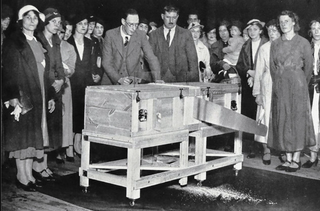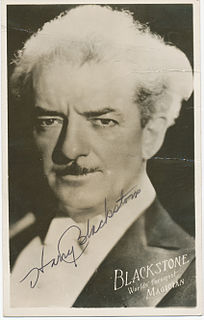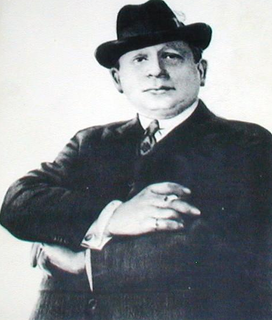
Escapology is the practice of escaping from restraints or other traps. Escapologists escape from handcuffs, straitjackets, cages, coffins, steel boxes, barrels, bags, burning buildings, fish-tanks, and other perils, often in combination.

P. T. Selbit (1881–1938) was an English magician, inventor and writer who is credited with being the first person to perform the illusion of sawing a woman in half. Among magicians he was known for his inventiveness and entrepreneurial instinct and he is credited with creating a long list of successful stage illusions.

Sawing a woman in half is a generic name for a number of stage magic tricks in which a person is apparently sawn or divided into two or more pieces.

Harry Bouton Blackstone was a famed stage magician and illusionist of the 20th century. Blackstone was born Harry Bouton in Chicago, Illinois. He began his career as a magician in his teens and was popular through World War II as a USO entertainer. He was often billed as The Great Blackstone. His son Harry Blackstone Jr. also became a famous magician. Blackstone Sr. was aided by his younger brother, Pete Bouton, who was the stage manager in all his shows. Blackstone Sr. was married three times. Blackstone Jr. was his son by his second wife.
The Mismade Girl is a stage illusion, designed by American magician Chuck Jones. It is a variation of the sawing a woman in half illusion.
The Zig-Zag Girl illusion is a stage illusion akin to the more famous sawing a woman in half illusion. In the Zig-Zag illusion, a magician divides an assistant into thirds, only to have them emerge from the illusion at the end of the performance completely unharmed.

Jim Steinmeyer is an American author, inventor, and designer of magical illusions and theatrical special effects. He holds four US patents in the field of illusion apparatus, including a modern version of the Pepper's Ghost illusion. Steinmeyer has consulted for many famous magicians, including David Copperfield, Doug Henning, Siegfried and Roy, and Lance Burton.

The Aztec Lady is a stage illusion designed by British magician Robert Harbin. It is a classic "big box" illusion that involves an assistant in a cabinet and is probably best categorised as a restoration-type illusion.

Valentine Augustus Walker was an English magician, escape artist and illusion designer. He was born in Moseley, Birmingham to Joseph Walker, a landscape gardener, and his wife Emma. Val Walker worked as an electrical apparatus maker, later serving in the Royal Navy and was billed as the "Wizard of the Navy". Walker is credited as the designer of the Radium Girl illusion. His most famous escape was "The Tank in the Thames" where he was bolted into a steel tank lowered into the river Thames from the Sea-Scout Training Ship, Northampton on 20 August 1920. He escaped in 20 seconds. He was married in 1913 to Ethel Dora Harris, the daughter of Thomas Daniel Harris and his wife Emma Ellson. He retired from the stage in 1924, returning briefly in 1939, under the name of 'Val Enson', with an illusion called "The Aquamarine Girl".
Henry Jeffery Atkins was a British magician. He is cited as a major force in the International Brotherhood of Magicians (IBM) British Ring, for which he was honorary secretary and convention organizer for many years. He also served a term as international president of the IBM. As a performer he specialized in revivals or re-creations of antique magic. He made a number of appearances on national television in the United Kingdom. On one occasion he staged a revival of the Radium Girl illusion for the Paul Daniels Magic Show. He is commemorated through the Jeffery Atkins memorial lecture held at the annual convention of the British Ring of the IBM.
The table of death is a predicament escape that may be regarded as a magic trick or an act of escapology.

The Devil's Torture Chamber is a magic stage illusion of the classic type involving a female magician's assistant in a large box and is probably best categorised as a penetration or restoration-type illusion.

Horace Goldin was a stage magician who was noted for his rapid presentation style and who achieved international fame with his versions of the sawing a woman in half illusion.
A magician's assistant is a performer in a magic act who is not billed as the magician or principal name in the act. The role of an assistant can include holding the props that are used by a magician, shifting props onto and off the stage, and serving as a living prop in illusions that involve manipulation of the human body. Other aspects of the role can include dancing or acting as visual ornamentation, sometimes for simple aesthetic purposes and sometimes to misdirect audience attention. The figure of the glamorous female assistant has become a stereotype or icon in art, popular media and fiction.
Alan Robert Wakeling (1926–2004) was an American magician and inventor who is known in the magic world for devising classic illusions and routines used by some of the top performers in the business. Some of his most successful work was done in association with leading television magician Mark Wilson. They worked on the television show The Magic Land of Allakazam, which was sponsored by Kellogg's cereal, and aired on CBS every Saturday from October 1st 1960 then moved to ABC in 1962.

The Drill of Death is a large-scale stage illusion in which a performer appears to be impaled on a giant drill. It was created by magician André Kole and illusion designer Ken Whitaker for magician Melinda Saxe. It was one of Saxe's signature tricks and featured as a highlight in her various First Lady of Magic shows.
Stage illusions are large-scale magic tricks. As the name implies, stage illusions are distinct from all other types of magic in that they are performed a considerable distance away from the audience, usually on a stage, in order to maintain the illusion. Stage illusions usually use large props and may involve the use of assistants or large animals. Examples of stage illusions include sawing a woman in half and Lady-to-Tiger.
Clearly Impossible is a variation of the illusion of sawing a woman in half devised by Jonathan Pendragon.

Jonathan and Charlotte Pendragon were a husband-and-wife team of American illusionists who called their work "physical grand illusion". They are widely known due to numerous national and international television appearances.












